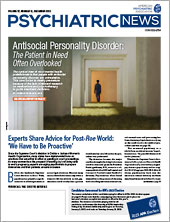Psychodynamic psychotherapy was once a cornerstone of psychiatric training and practice. Historically, most psychiatrists would have felt comfortable exploring patients’ unconscious and interpersonal issues in weekly therapy sessions. In contemporary psychiatry, however, psychodynamic thought has lost its preeminence. Managed care’s preferential reimbursement of psychopharmacology and reliance on lower-cost therapists compounded by the mistaken belief that psychodynamic psychotherapy lacks empirical support led to a steady decline in psychiatrists providing psychodynamic psychotherapy. Ironically this occurred simultaneously with the emergence of a literature demonstrating the efficacy and cost-effectiveness of psychodynamic psychotherapy in managing personality disorders, chronic depression, and anxiety. What can psychiatry do to preserve the benefits engendered by a psychodynamic understanding of patients?
In addition to promoting psychodynamic psychotherapy, psychiatric training should focus on the advantages of incorporating psychodynamic thought into a wider range of patient interactions. Psychodynamically informed psychiatrists can emphasize once commonly held beliefs such as these:
•
Everyone has an active unconscious that in part dictates their desires, reactions, and behaviors.
•
Past experiences shape one’s current relationships, emotions, and decisions.
•
People tend to form recurring patterns of relationships often based on early childhood models.
•
The relationship between the psychiatrist and patient contains both diagnostic and therapeutic potential.
We must act quickly, however, if we want a psychodynamic orientation to remain a core feature of psychiatry; the last generation of psychiatrists who were steeped in psychodynamic thought are rapidly reaching retirement age. Some psychiatrists, especially those in private practice, are able to offer traditional psychodynamic psychotherapy, but all psychiatrists can still inculcate a psychodynamic understanding into routine clinical care. Consider the following example:
A young man was seen in the ICU by the consultation/liaison team. He had cut his wrist and taken an overdose of acetaminophen. When the resident sat down with him, the patient was curt and dismissive. “Let’s get this over with. ... I was suicidal, but I am not anymore. I have seen the error of my ways. I promise.”
Despite the aggressiveness of these remarks, the resident sensed the patient was more scared than angry. She asked why he was trying to push her away when she was trying to help him. He became suddenly tearful, “That is what they always say. You pretend to care, but when I need you, no one is there for me.” Recognizing that the intensity of his response came from previous disappointments, she tried to reassure him of her desire to help and said, “It sounds like people have let you down before. I wonder if that had something to do with you trying to kill yourself.” This led to a conversation about his chronic relationship struggles and the argument with a close friend that had precipitated the suicide attempt.
A minimal psychiatric response to this situation would be to thoroughly document a risk assessment and make recommendations about psychopharmacology. A psychodynamic psychiatrist would reflect on what these interactions say about the patient’s past experiences and inner life and how those factors should guide her approach to the patient.
The consultation/liaison resident encouraged the patient to discuss the relationship with his friend and their distressing conversation. She then asked him to consider a different perspective.
“You two sound very close. You have felt rejected by many people in your life, but maybe his spending time with other people is not a rejection of you. I wonder if there are parts of his life that don’t involve you, just like there are parts of your life that don’t involve him.” The patient nodded. “Well, he was going over to play some stupid online game. He knows that I get bored with that stuff. He has asked me before, and I have always said ‘no.’ ” The resident suggested, “So maybe he didn’t invite you because he knew you wouldn’t want to go.”
The resident’s understanding of the patient’s interpersonal vulnerabilities allowed her to strengthen their therapeutic alliance and to help the patient re-examine long-standing, unconscious beliefs about his relationships. She continued his current medications without change and arranged for a next-day appointment with his outpatient therapist.
Retaining a psychodynamic orientation can deepen our understanding of patients and guide our interactions wherever we work. We should not settle for a reductionistic view of patients’ symptoms, as if their primary problem was a medication deficiency. Today’s psychiatrists can incorporate these practical psychodynamic principles into their everyday work and thereby provide the comprehensive care that patients need and deserve ■

